Ancient Egyptian Technology
Much can be attributed to the ancient Egyptians, even some of the earliest forms of technology and inventions that we still use today. They were innovators in astronomy, mathematics, medicine, language and even architecture. In fact, the list of inventions in ancient Egypt can be quite a lengthy document.
While ancient Egypt is usually associated with pharaohs, mummies and pyramids, a great number of ancient Egyptian inventions are still used in our everyday lives.
Paper and Writing
Hieroglyphics
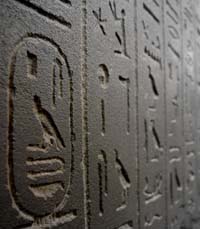
The ancient Egyptians were among the first groups of people to write and keep records of events that happened in their lives. The earliest form of writing was in the form of hieroglyphics, which, simply put, were drawings that portrayed a story. Hieroglyphics are some of the oldest artifacts in the world today, and the Egyptians used them to keep accurate records and maintain control of their empire.
Click here to discover more about Hieroglyphics
Papyrus

Papyrus was the first form of durable sheets of paper to write on, and the ancient Egyptians were the ones to develop it. The material was termed “papyrus” because it was made from the papyrus plant.
The ancient Egyptians primarily used papyrus for recording religious texts and other important documents. Papyrus was mass produced in Egypt and sold to other ancient civilizations, such as Ancient Greece, for their record keeping.
Click here to discover more about Papyrus
Ink
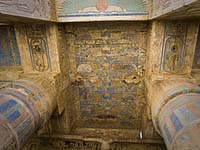
One of the inventions in Egypt was, surprisingly, black ink. The Egyptian people were very talented at creating not only black ink, but many multi-colored types of ink and dye. The process and depth of color utilized in the Egyptian invention of ink and dye was so marvelous that these brilliant hued colors can still be seen today, thousands of years later.
Time Telling
Calendars

The ancient Egyptian calendar was invented more than 5,000 years ago and was originally based on the 12-month lunar cycle. They grouped the months into three seasons of four months that seemed to coincide with the Nile River.
However, this calendar wasn’t accurate enough. They soon noticed that although the river would flood every year around the end of June, the flood occurred within a range of 80 days.
Therefore, after noticing that the river’s flooding and rising coincided with the heliacal rising of the star Sirius, they based their year on the cycle of this star’s reappearance, effectively applying astronomy principles to develop a more accurate calendar by which to track the days of the year. We still use ancient Egyptians' calendar model in our tracking of the days today.
Clocks

Ancient Egyptians were also one of the first groups of people to divide days into equal parts through the use of timekeeping devices. Some of the earliest forms of clocks were sundials, shadow clocks, merkhets and obelisks.
Generally, the passing of the day was determined by the position of the sun, and the passing of the night was determined by the rise and fall of the stars.
There is even evidence of water clocks in ancient Egypt. These were shaped like bowls and had a small hole in the bottom of them. They floated atop water and were allowed to fill up in a way so that the rising water represented a number of hours passing.
Water clocks were mostly used by priests, as they allowed a way to measure time independently of the sun and were more accurate gauges of time for performing special religious ceremonies.
Construction
The ancient Egyptians are known for their massive constructions and outstanding architecture. Many of their earliest buildings are no longer standing, having been subjected to war, ruin and other elements. The ones that are remain marvels of architecture, such as the Great Pyramid of Giza, which is one of the Seven Wonders of the World.
Pyramids

There remains speculation regarding how the ancient pyramids were constructed. However, the first truly triangular shaped pyramids are counted among the many ancient Egyptian inventions, although it took them several tries in order to achieve an ideal model.
Organized Labor

The Egyptians were the first to invent and employ organized labor on a massive scale in order to construct these magnificent stone structures.
When one takes into consideration that the construction of just one pyramid often lasted several decades, the magnitude of the organized labor required becomes enormous.
Simple Machines
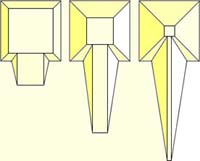
Part of what made it possible for the Egyptians to build some of the great buildings and monuments that they did was the employ of certain simple machines that they invented to assist them in the process. The ramp and the lever were a couple of the most famous construction inventions that the ancient Egyptians developed, and the principles that guide them are still widely used in construction today.
Ships and Navigation

Trade was an important part of ancient cultures, so having working ships was extremely important. The ancient Egyptians employed knowledge of the science of aerodynamics in their ship construction processes to create ships that would catch the wind and push vessels through the water. They developed the use of numerous sails that could be adjusted to sail ships against the wind using side winds.
They also came up with the concept of using rope trusses to strengthen the beams of their ships, and they were also the first ones to stem-mounted rudders on their ships. At first, they built small boats out of papyrus reeds, but eventually they began to build larger ships from cedar wood.
Agriculture
Agriculture was extremely important to ancient civilizations, as it still is today. Without sufficient crops, there isn’t enough food for humans to survive.
Ox-Drawn Plow

While not thought of in quite the same aspects as the tools we know today, the first ox-draws plows appeared in Egypt as early as 2500 B.C. This advancement in agriculture required skilled metal working in order to form a workable plow, as well as animal husbandry.
One might wonder why the ancient Egyptians would have even needed ox-drawn plows when the majority of the Egyptian nation consists of deserts. While there certainly is a great amount of sweeping desert land in Egypt, the nation is also the home of extremely fertile black soil along the banks of the Nile River. This area provided a very hospitable environment for growing crops such as wheat, in addition to a multitude of vegetables.
Irrigation

Of course, humans cannot control the amount of rainfall that is supplied to the Earth. Therefore, the ancient Egyptians developed irrigation systems using hydraulic engineering principles. Such systems were designed to replace rainfall during periods of drought. Early evidence indicates that irrigation systems were used in ancient Egypt as early as the twelfth dynasty, using the lake Fayum, as the reservoir to store water surpluses.
Weapons
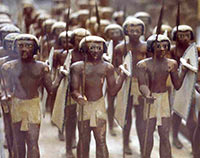
Prior to the Egyptian civilization, weapons used for protection, hunting or in combat were very basic. During the ancient Egyptian civilization, weapons became more and more sophisticated. Examples are stone-tipped arrows, battle axes, chariots, the khopesh, maces, body armor, slingshots and much more.
Discover more about ancient Egyptian weapons
Crafts
Glass
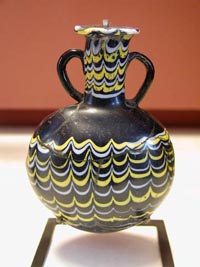
Ancient Egyptians had advanced knowledge of glass-working. They supposedly crafted glass beads of different colors as early as 1500 BC during the time period of the New Kingdom. Their glass working abilities gave them advantages in trade since such works were viewed as highly valuable.
Beads were made by winding molten glass around a metal bar and were believed to have had magical powers. The ancient Egyptians made more than glass beads, though. They also crafted glass jars and bottles as well as glass thread and cast glass that was placed into a mold.
Furniture

There is even evidence that the Egyptians invented a wide variety of furniture. Some ancient Egyptian artifacts include beds, tables and stools that were recovered in ancient Egyptian tombs and after which much of today’s modern furniture is modeled.
Science
The ancient Egyptians excelled at the sciences and had knowledge in various fields, from astronomy to mathematics. Many of their most famous inventions were based upon the scientific principles they discovered.
Astronomy
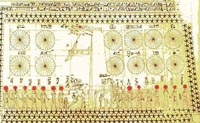
The Egyptians made observations about the night sky, and their religion and heavenly bodies were greatly influenced by the sky and elements. Egyptians studied the rise and fall of the stars and even built circular mud-brick walls to create false horizons where they could mark the position of the sun as it rose at dawn.
Then, they used plumb-bobs to make note of the solstices. They used their knowledge of astronomy to develop the lunar calendar based on the cycles of the moon and the star, Sirius. From their knowledge emerged the calendar that we use today, divided in 12 months, 365 days and 24-hour units.
Medicine
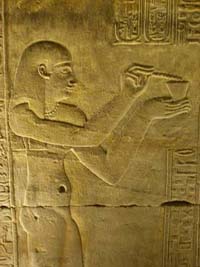
Some of the earliest developments in medicine were made by the ancient Egyptian people. They had a variety of medicines and cures for both humans and animals, along with much knowledge of anatomy, as they practiced mummification and preservation of the dead.
One of the earliest accounts of medical texts originates in ancient Egypt. It attempts to describe and analyze the brain, providing the earliest insight into neuroscience. Although they had many “cures” for various ailments, some of their medicinal practices were questionable at best.
For instance, they used honey and human brains to cure eye infections, a cooked mouse to cure coughs and applied cow dung to wounds and piercing to ward off infections. There are indications that the use of such practices was one of the leading causes of people developing tetanus in ancient Egypt.
Because the ancient Egyptians were highly spiritual people as well, it should come as no surprise that they also accompanied many of their cures with spells that were supposed to ward off the evil spirits that were making patients sick.
Mathematics
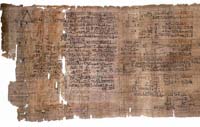
The great pyramids that the ancient Egyptians built required some knowledge of mathematics, especially of geometry. Mathematical principles were applied in the invention of simple machines, as well as for transactions and record keeping.
Math and numbers were used to record business transactions, and the ancient Egyptians even developed a decimal system. All their numbers were factors of 10, though, such as 1, 10, 100 and so on. Therefore, in order to denote 3 units, they would write the number “1” three times.
Electricity
Although the implementation of electricity into the world didn’t come until much, much later, some historians believe that there is evidence that the ancient Egyptians had some form of understanding of electricity. They reportedly observed lightning and interacted with electric fish, making records of the electric phenomena that they observed.
One ancient Egyptian text makes reference to “high poles covered with copper plates”, which some believe to be an early reference to electric phenomena. However, other historians have argued that this was not a reference to electricity, but to some sort of magical belief.
Cosmetics
Dental Hygiene

Many people don’t realize that toothpaste is actually another invention that can be attributed to the ancient Egyptians. Because their bread had so much grit and sand in it, Egyptians experienced problems with their teeth. They invented the toothbrush and toothpaste in an effort to care for their teeth and keep them clean of grit and sand.
The first toothpaste was made of a wide variety of ingredients, some of which included eggshells, ashes and ground-up ox hooves.
Ancient Egyptians not only invented toothpaste, but they invented breath mints as well to cover bad breath aromas. The mints were made up of myrhh, frankincense and cinnamon that was boiled in honey and shaped into small, bite-sized pellets they could suck on.
Make-up

Even make-up originated with the ancient Egyptians, where men and women alike used to wear it. While the make-up was used primarily for cosmetic purposes and as a fashion statement, it served a practical purpose as well, in that it protected their skin from the sun.
Perhaps the makeup that they are most known for was the dark kohl that they wore around their eyes. Kohl was made from soot and other minerals and is the concept from which modern eyeliner originated.
Facts about Technology and Invention in Ancient Egypt
- Although the ancient Egyptians are often attributed with the invention of the wheel, they actually did not start using it until it was introduced to them by foreign invaders.
- The word that the Egyptians used for papyrus was actually a Grecian word for the papyrus plant, rather than an Egyptian one.
- Egyptians denoted the number one million as a picture of a god with his arms raised in the air rather than as a number.
- The game of bowling actually originated with the Egyptians who invented a game similar to it in that a ball was rolled into a hole by a bowler rather than at knocking down pins.
- The Egyptians invented large door locks with keys, and some of the keys were up to two feet long.
- Although Egyptians are attributed with creating black ink, they also created various other colors of ink as well.
- The first ox-drawn plow was also invented in ancient Egypt.
